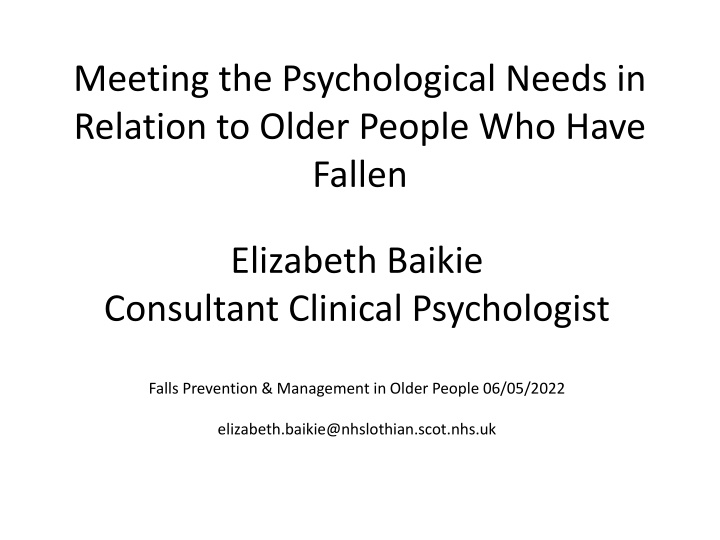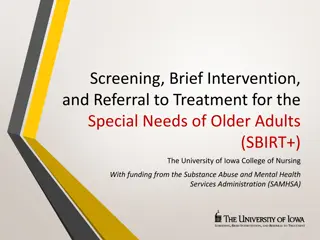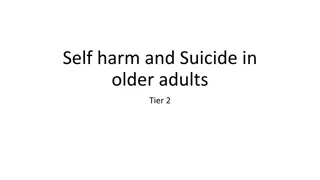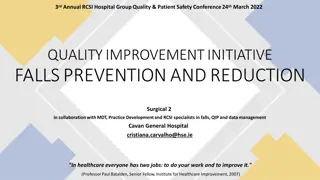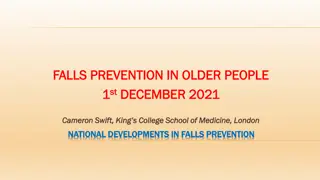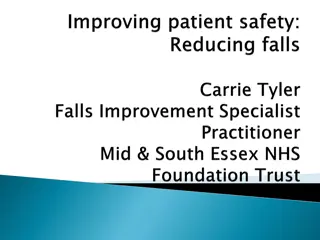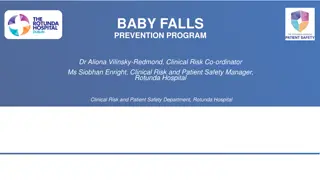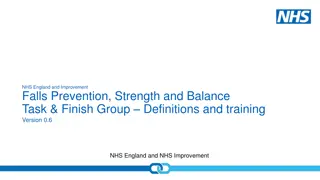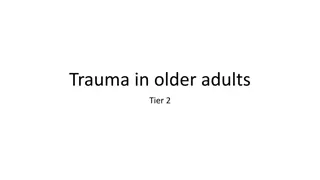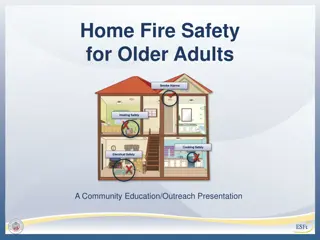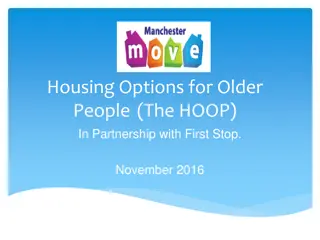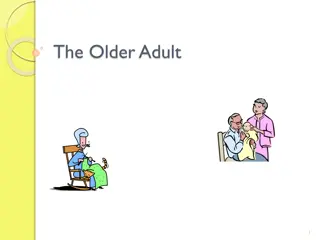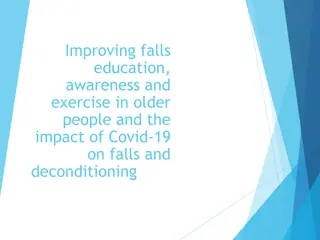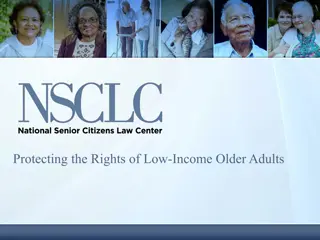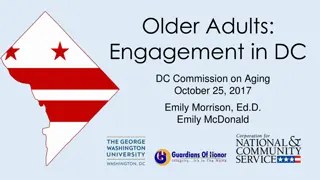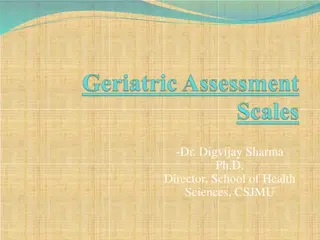Meeting Psychological Needs in Older Adults: Falls Prevention & Management
Elizabeth Baikie, Consultant Clinical Psychologist, shares insights on identifying and managing psychological needs in older people who have fallen, emphasizing autonomy, quality of life, and the role of activity in enhancing well-being.
Download Presentation

Please find below an Image/Link to download the presentation.
The content on the website is provided AS IS for your information and personal use only. It may not be sold, licensed, or shared on other websites without obtaining consent from the author.If you encounter any issues during the download, it is possible that the publisher has removed the file from their server.
You are allowed to download the files provided on this website for personal or commercial use, subject to the condition that they are used lawfully. All files are the property of their respective owners.
The content on the website is provided AS IS for your information and personal use only. It may not be sold, licensed, or shared on other websites without obtaining consent from the author.
E N D
Presentation Transcript
Meeting the Psychological Needs in Relation to Older People Who Have Fallen Elizabeth Baikie Consultant Clinical Psychologist Falls Prevention & Management in Older People 06/05/2022 elizabeth.baikie@nhslothian.scot.nhs.uk
Overview Psychological Needs/Values & Life Satisfaction/Quality of Life Psychological Consequences of Falls Identifying & Managing Fear of Falling Supporting People to Regain Confidence and Reduce Anxiety after a Fall
Psychological Needs and Quality of life NEEDS Autonomy QOL Sensory abilities Autonomy Past, present and future activities Social participation Attitudes towards death and dying Intimacy Competence Relatedness (Self-Determination Theory, Deci & Ryan, 1985) WHOQOL-OLD (Power, Quinn Schmidt, 2005) 24 items: 6 facets rated on a 5-point Likert scale
Values what we find meaningful in life (Acceptance and Commitment Therapy) Family relations Marriage / couple/ intimate relations Parenting Friendships / social relationships Employment Education / training / personal growth Recreation Spirituality Citizenship /community Physical wellbeing (NB lockdown: not going out or having visitors affected mood, as did mobility)
Needs of people [with or without dementia] living in care homes during the COVID-19 PANDEMIC (Marshall, James and Carter, NHS Tees, Esk and Wear Valleys, 2020)The Needs Tree: the 8-needs framework Physical comfort and freedom from pain Control over environment and possessions Occupation and exploration Perception of safety Esteem Love and belonging Positive touch fun
Role of Activity Depression was the most powerful predictor of QOL Regular participation in physical activity important for QOL, as well as physical and cognitive function, preventing obesity (Borowiak & Kostka, 2004). Satisfaction of the psychological needs of autonomy, competence and relatedness was related to exercise, intrinsic motivation and self-determined autonomy (Kirkland et al, 2011) Cl Satisfaction of these basic psychological needs is important when considering exercise and how it relates to falls reduction Purposeful activities can improve mood
Psychological Consequences of Falls Fear, anxiety, loss of confidence and subsequent increasing activity avoidance, social isolation and frailty (Parry et al, 2014, STRIDE study) Reduction in pleasurable/purposeful activities Reduction in quality of life Depression PTSD (Chung et al, 2009); (Jayasinghe et al, 2014) (Anger)
Psychosocial Consequences of Falls Maintenance of anxiety Over-protectiveness of relatives: You sit down, I ll do it . Don t go out in the garden on your own, bending can lead to over- balancing Reduction in sense of control, incl. role reversal Staff behaviour? Safety versus risk and autonomy
Falls and Fear Of Falling: which comes first (Friedman et al, 2002) Falls at baseline were an independent predictor of developing FOF 20 months later FOF at baseline was a predictor of falling at 20 months Women with a history of stroke were at risk of both at follow-up. Parkinson s disease, comorbidity and racial background predicted falls, whereas GHQ score, age and taking 4 or more meds predicted fear of falling Individuals who limit activites because of FOF are at high risk of faling, due to decline in function, also they have a higher prevalence of risk factors
How Does Fear of Falling Develop? Situational triggers/associations may lead to specific avoidance Eg steps up to church has not been back since Rushing for waiting taxi and over- balancing Rushing when door or phone has rung previous fall on bus or stepping on to a bus Combined with health factors
Attributions Causes of falls may be: Extrinsic, eg obstacles loose mats, wet leaves, tramlines Intrinsic, eg eyesight, medication Attributions may be specific or general
Changes in Thinking Increased awareness of ageing after a fall I fell because I m getting older/old now. I d better be careful v I fell because the plumber left his bag in the dark hall. Increased concern about physical health I m dizzy all the time. Seems to have started after my TIAs. I m likely to fall outside on my own . I d better not go out v Sometimes I feel dizzy. It s worse when I get up quickly. I m ok if I get up slowly and am fine with short walks .
Avoidance Avoidance may generalise, eg original fall due to trip at home leading to avoidance of going out Strengthens fear/phobic avoidance Leads to deconditioning and poorer balance
Maintenance of anxiety Cognitive Behavioural approach - vicious circle Thoughts I fell so I must be getting old and infirm Physical feelings Dizzy -Shaky Feelings Anxiety/panic Behaviour Hyperventilation Reduction in physical activity -Avoids walking alone or going out alone -
3. Psycho-education (from Heather Langham, 2013)) Maintenance of anxiety Cognitive Behavioural approach - vicious circle Thoughts If I walk by myself I will fall over and hurt myself Physical feelings -Heart race increases -Breathing quickens -Shaky Feelings Anxiety/panic Behaviour -Avoids walking alone -Seeks staff support if needs to walk anywhere
Six Types of Helping Strategies (Scally & Hopson, 1977) Giving advice: offering your opinion on best course of action Giving information needed for a particular situation Direct action Teaching Systems change Counselling Counselling and Helping, Barrie Hopson. In Psychology and Medicine (1981) ed. Chapman & Gale. Pub. The British Psychological Society
Interdisciplinary interventions for fear of falling (Gomez & Curcio, 2007) Medicine: Aim - decreasing medical risk factors Management of falling risk factors: visual deficit, arthritis, dizziness, polypharmacy and drug reactions, orthostatic hypotension anxiety & depression, patient and caregiver education
Physiotherapy: Aim increasing functional ability in physical and instrumental ADL Individualised and group-based interventions Transfers training Aerobic endurance, flexibility, strength, and balance training Walking in extreme situations program (opened and closed eyes) Landing and standing strategies Assistive devices adaptation Health promotion and education in falling risk factors
Psychology: Aim - improving emotional functioning and adapting behaviour change Cognitive-behavioural therapy Patient and caregiver training Management of anxiety and depression Occupational therapy: Aim - obtaining competent and safe performance Adaptive rehab in items of Self Efficacy scale Environmental risk assessment Adaptive strategies in extreme situations
Social work: Aim increasing social participation Stimulating familiar activities and help support Promoting social contacts and social participation Case management as necessary Patient and caregivers education
Assessment Identify triggers Specific situations *Cognitions/thinking style, eg mental filter, prediction, mountains and molehills, catastrophising and black and white thinking Previous fall Knowing someone who s fallen Coping strategies Weigh up pros and cons of change, eg reduction in social isolation *www.getselfhelp.co.uk/unhelpful.htm
Psychological interventions continued Overactivity/rest cycle and pacing (NB pain) Selection, optimisation and compensation for activites, e.g., golf; playing a few holes, going to the practice range etc. Systemic work with families not all or nothing Doing things in a graded way or together
Conclusions Identify the person s goals *Promote motivation Cost/benefit analysis Provide psychoeducation about anxiety Identify relevant cognitions and thinking style Identify safety behaviours Work with other colleagues *eg the environment: PJ paralysis (2019) *behavioural charts
